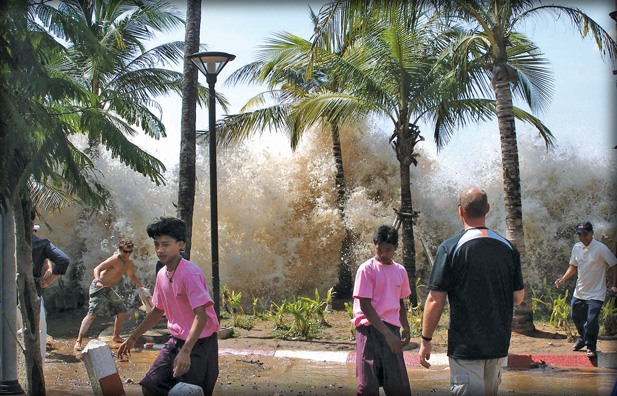Tsunami 2004: ADB's response and lessons learned
Ten years on from the Asian Tsunami of 2004, stronger and more
resilient communities are enjoying the fruits of a reconstruction effort
that also served as invaluable experience in the aftermath of other
natural calamities.
 As one of the worst natural disasters in memory to hit the
Asia-Pacific region, the 2004 earthquake and tsunami killed more than
260,000 people and displaced more than 1.7 million people in 14
countries. India, Sri Lanka, and Thailand were affected, but it was the
Indonesian province of Aceh, close to the epicenter of the earthquake at
sea, that suffered the most. As one of the worst natural disasters in memory to hit the
Asia-Pacific region, the 2004 earthquake and tsunami killed more than
260,000 people and displaced more than 1.7 million people in 14
countries. India, Sri Lanka, and Thailand were affected, but it was the
Indonesian province of Aceh, close to the epicenter of the earthquake at
sea, that suffered the most.
Within six weeks of the disaster ADB set up a $600 million
multi-donor Asian Tsunami Fund grant facility, including the largest
ever single ADB grant - $300 million to Indonesia. In total, ADB
eventually committed $851 million for tsunami-related assistance.
"We rapidly responded, acting in close coordination with the affected
governments, local communities and development partners," said Director
General, ADB's Southeast Asia Department and former ADB Country Director
for Indonesia, Jim Nugent.
Ten years on from this unprecedented disaster, the progress achieved
has been remarkable and the lives of many of those affected by the 2004
tsunami have improved immensely.
In India, the Maldives, Sri Lanka and Thailand, several
reconstruction programs have been successfully completed, livelihoods
restored and the long-term sustainability of economies rebuilt.
ADB's biggest post-tsunami reconstruction commitment was in Aceh.
Along with other development partners and using the multi-donor fund,
nearly 20,000 houses have been reconstructed, 600 kilometres of national
road restored, 1,600 km of irrigation channels built, 677 schools
rehabilitated and 8,000 new wells dug in the province.
ADB rebuilt houses in Aceh more slowly than some other donors, taking
time to establish land rights and consult with communities. A decade on,
this sustainable approach has paid off.
Zahrul Fuady lost eight members of his family when his house was
destroyed by the water. He now lives in a suburb of the main city, Banda
Aceh. In this suburb, most of the houses were built by the ADB.
"The ADB houses are still very sound. It's eight years now since they
were constructed. Having the right services is also important and trees
were planted too, so it means quality of life for us in this suburb was
better than before," he said.
The same ethos of sustainable reconstruction was at the core of
infrastructure development after the tsunami in Aceh. The ADB funded
eight power supply and distribution projects in six districts in Aceh
after the tsunami.
Sulaiman Daud is a power sector manager working for the provincial
electricity board in Aceh. He was in the frontline after the tsunami,
toiling for months with his overstretched crews to reconnect the
province's power supply that had been disrupted in a thousand places.
"The power infrastructure that the ADB funded here is good quality
generally, it's more sustainable, and we have a better grid system than
before the tsunami," he said.
"Right now we have 90% electrification throughout the province. The
system can take a peak load of 85 megawatts, compared with just 40
megawatts before the disaster," Daud said.
Reviving agriculture to reduce rural poverty was critical in
predominantly agrarian Aceh. A US $20 million grant from the ADB for new
irrigation channels helped rehabilitate 50,000 hectares of farmland on
the north Aceh coast.
Community participation and local ownership were key to the success
of the project, with most of the new irrigation work carried out by
farmers themselves.
One positive effect of the tsunami was that it was instrumental in
bringing the brutal 30-year conflict in Aceh to an end.
This allowed farmers to work in peace for the first time in a
generation, helping to boost agricultural output and promote
livelihoods.
"The new irrigation channels have helped a lot, we now have two crops
of rice per year and production per hectare has doubled from four tons
to eight tons. This has really helped increase rural income," said Aceh
Provincial Agriculture Development Officer, Kharril Hadi.
A decade on from the Asian Tsunami, would the ADB, in hindsight, have
responded differently to the disaster?
"One thing that we would do differently today is that we would
respond even faster to a disaster like this," said ADB Country Director
in Indonesia, Adrian Ruthenberg.
"Today, we are better prepared, with the whole of ADB ready to
respond quickly.
|

